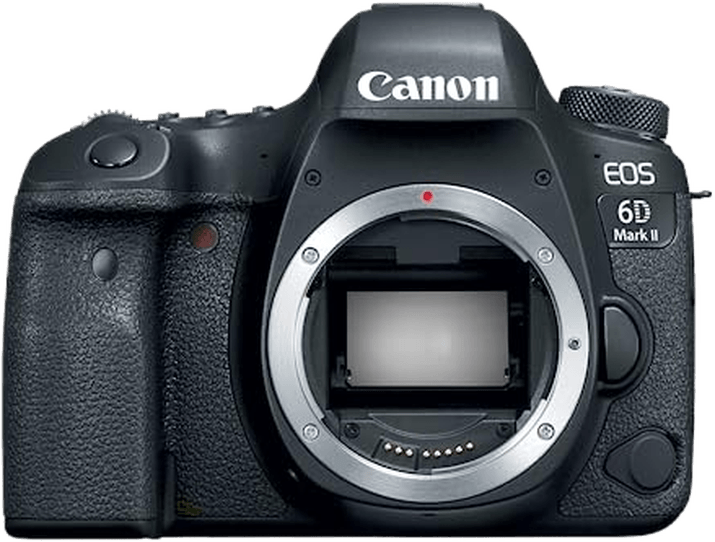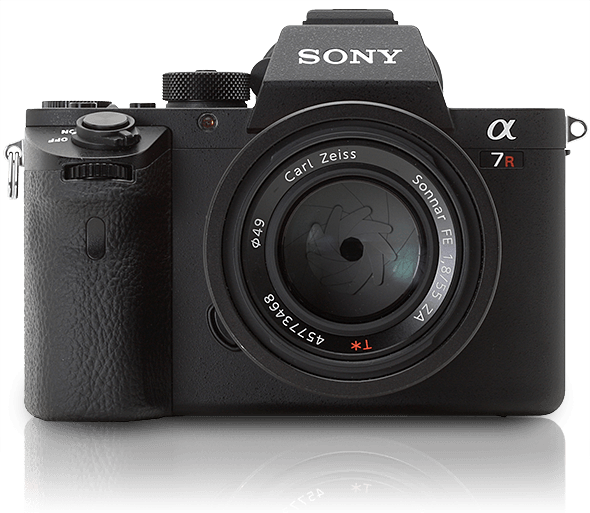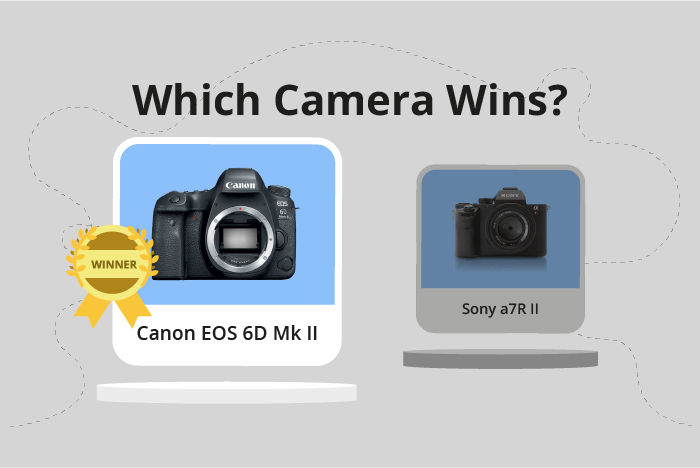Canon EOS 6D Mark II vs Sony a7R II Comparison
Canon EOS 6D Mark II

Sony a7R II

The Canon EOS 6D Mark II edges out the Sony a7R II by one point, scoring 71/100 compared to Sony’s 70/100. Both cameras were released in the mid-2010s, with the Canon in 2017 and the Sony in 2015. They share similarities in announcement dates and launch prices, though the Canon is priced lower at $2000 compared to the Sony’s $3198.
The Canon EOS 6D Mark II is a DSLR camera, while the Sony a7R II is a mirrorless camera. The Canon is lighter, weighing 453g, and has a larger body, measuring 144 x 111 x 75mm. In contrast, the Sony a7R II is heavier at 625g and has a smaller body, measuring 127 x 96 x 60mm.
Given their respective scores and specifications, the Canon EOS 6D Mark II offers a more budget-friendly option with a lighter weight, while the Sony a7R II provides a more compact design. Your choice depends on personal preferences and priorities in camera features.
Canon EOS 6D Mark II vs Sony a7R II Overview and Optics
The Sony a7R II comes out on top in the optics comparison with a score of 81/100, while the Canon EOS 6D Mark II scores 69/100. Both cameras share several specifications, including full frame sensor size, CMOS sensor type, and respective lens mounts (Canon EF for the 6D Mark II and Sony FE for the a7R II).
The Sony a7R II excels in several aspects, such as a higher megapixel count of 42.4 compared to the Canon’s 26.2, which translates to better image resolution. Additionally, the a7R II has a superior DXOMARK sensor score of 98, compared to the 6D Mark II’s 85, indicating a better overall sensor performance. Another important advantage of the Sony a7R II is the presence of image stabilization, which is absent in the Canon 6D Mark II. This feature helps to reduce camera shake and produce sharper images.
On the other hand, the Canon EOS 6D Mark II has a faster shooting speed of 6.5 frames per second (fps) compared to the Sony a7R II’s 5 fps. This can be advantageous in capturing fast-moving subjects or situations where a quick response is necessary. The Canon 6D Mark II is also powered by the Digic 7 processor, while the Sony a7R II uses the Bionz X processor, although it is not clear if this results in any significant performance differences between the two cameras.
Taking into account the various factors discussed, the Sony a7R II emerges as the superior camera in terms of optics, with its higher megapixel count, better sensor performance, and image stabilization. However, the Canon EOS 6D Mark II still holds its own with a faster shooting speed, making it a suitable choice for certain scenarios.
Canon EOS 6D Mark II vs Sony a7R II Video Performance
The Canon EOS 6D Mark II outperforms the Sony a7R II in terms of video capabilities, with a video score of 57/100 compared to the Sony a7R II’s 56/100. Both cameras share some common specifications, such as a maximum video frame rate of 30fps. However, there are key differences that set these two cameras apart in the realm of video performance.
The Canon EOS 6D Mark II boasts a full HD maximum video resolution with dimensions of 1920 x 1080. Additionally, the camera features built-in time-lapse functionality, which allows users to create stunning time-lapse videos without the need for additional equipment or software. This advantage makes the Canon EOS 6D Mark II a more versatile and user-friendly option for videographers.
On the other hand, the Sony a7R II offers a higher maximum video resolution of 4K, with dimensions of 3840 x 2160. This means that the Sony a7R II can capture videos with more detail and clarity compared to the Canon EOS 6D Mark II. However, it lacks built-in time-lapse functionality, which may be a drawback for some users.
Taking these factors into account, the Canon EOS 6D Mark II’s built-in time-lapse feature and user-friendly capabilities give it a slight edge over the Sony a7R II. However, for those who prioritize video resolution and detail, the Sony a7R II’s 4K capabilities may be more appealing. Ultimately, the choice between these two cameras will depend on the specific needs and preferences of the user.
Canon EOS 6D Mark II vs Sony a7R II Features and Benefits
The Canon EOS 6D Mark II emerges as the winner with a feature score of 83/100, while the Sony a7R II scores 57/100. Both cameras have a 3-inch screen size, flip screens, and WIFI capabilities.
The Canon EOS 6D Mark II outperforms the Sony a7R II in several aspects. It has a touchscreen, which makes navigation and operation more convenient and user-friendly. Additionally, it features GPS, allowing users to geotag their photos, providing valuable information for professional photographers and avid travelers. The Canon EOS 6D Mark II also includes Bluetooth, enabling seamless connectivity with other devices for quick image transfers and remote control.
On the other hand, the Sony a7R II has a higher screen resolution of 1,228,800 dots, compared to the Canon EOS 6D Mark II’s 1,040,000 dots. This results in a crisper and more detailed display, which can be helpful for photographers when reviewing images or composing shots.
In terms of common features, both cameras have a 3-inch screen size, flip screens, and WIFI capabilities. These features are essential for modern photography, allowing users to easily compose shots from various angles, connect to the internet, and share their work.
The Canon EOS 6D Mark II’s superior feature score highlights its advantages in touchscreen, GPS, and Bluetooth capabilities. Meanwhile, the Sony a7R II offers a higher screen resolution for improved image display. Ultimately, potential buyers should consider their specific needs and preferences when choosing between these two cameras.
Canon EOS 6D Mark II vs Sony a7R II Storage and Battery
The Canon EOS 6D Mark II outperforms the Sony a7R II in storage and battery with a score of 45/100 compared to Sony’s 16/100. Both cameras have one memory card slot and support SD, SDHC, and SDXC cards. However, the Sony a7R II also accepts Memory Stick Duo, Pro Duo, and Pro-HG Duo cards.
The Canon 6D Mark II has a significantly better battery life, offering 1200 shots per charge, while the Sony a7R II only provides 290 shots. The Canon uses an LP-E6N battery, whereas the Sony relies on an NP-FW50 battery. Neither camera supports USB charging.
In terms of storage and battery, the Canon EOS 6D Mark II is the clear winner with its longer battery life and compatibility with common memory cards. The Sony a7R II falls behind in this aspect, but its additional memory card support may be useful for some users. When considering storage and battery, the Canon EOS 6D Mark II is the better choice between the two.
Canon EOS 6D Mark II vs Sony a7R II – Our Verdict
Are you still undecided about which camera is right for you? Have a look at these popular comparisons that feature the Canon EOS 6D Mark II or the Sony a7R II:

